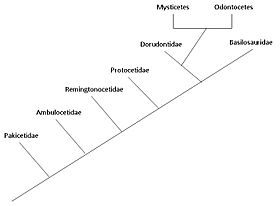Evolution of cetaceans facts for kids
The Cetaceans (whales, dolphins and porpoises) are mammalian marine descendants of land mammals. Their terrestrial origins are indicated by:
- Their need to breathe air from the surface;
- The bones of their fins, which resemble the limbs of land mammals
- The vertical movement of their spines, characteristic more of a running mammal than of the horizontal movement of fish.
The question of how land animals evolved into ocean-going leviathans was a mystery until recent discoveries in Pakistan revealed several stages in the transition of cetaceans from land to sea.
Contents
Fossil record
- Further information: Archaeoceti

Hippo fossils are not found until the Miocene, but whale ancestors have been found from the Eocene. This leaves a gap of nearly 30 million years where no hippo ancestors are found. The most recent hypothesis is that hippos and whales shared a common semi-aquatic ancestor which branched off from other Artiodactyls around 60 million years ago (mya). This ancestral group probably split into two branches around 54 mya. One branch evolved into cetaceans, possibly beginning with the proto-whale Pakicetus from 52 mya. These early cetaceans gradually became adapted to life in the sea. They became the completely aquatic cetaceans.
Indohyus

Indohyus is a small deer-like creature, which lived about 48 million years ago in Kashmir. It belongs to the artiodactyls family Raoellidae, and is believed to be the closest sister group of Cetacea.
About the size of a raccoon or domestic cat, this herbivorous creature shared some of the traits of whales. It also showed signs of adaptations to aquatic life, including a thick and heavy outer bone coating. This is similar to the bones of modern creatures such as the hippopotamus, and reduces buoyancy so that they can stay underwater. This suggests a similar survival strategy to the African mousedeer or water chevrotain which, when threatened by a bird of prey, dives into water and hides beneath the surface for up to four minutes.
Size
Scientists from the University of Plymouth studied many animals that dive and hold their breath, from insects to whales, and they found that larger animals can hold their breath longer than smaller animals because they can store more oxygen for their size, and this difference was much bigger for warm-blooded animals than for cold-blooded animals. They said this may be why modern whales and extinct diving animals like plesiosaurs became so large.
Images for kids
-
Cladogram showing the position of Cetacea within Artiodactylamorpha
-
Archaeocetes (like this Basilosaurus) had a heterodont dentition
-
Artistic impression of two Eobalaenoptera pursued by the giant shark Otodus megalodon
See also
 In Spanish: Evolución de los cetáceos para niños
In Spanish: Evolución de los cetáceos para niños








